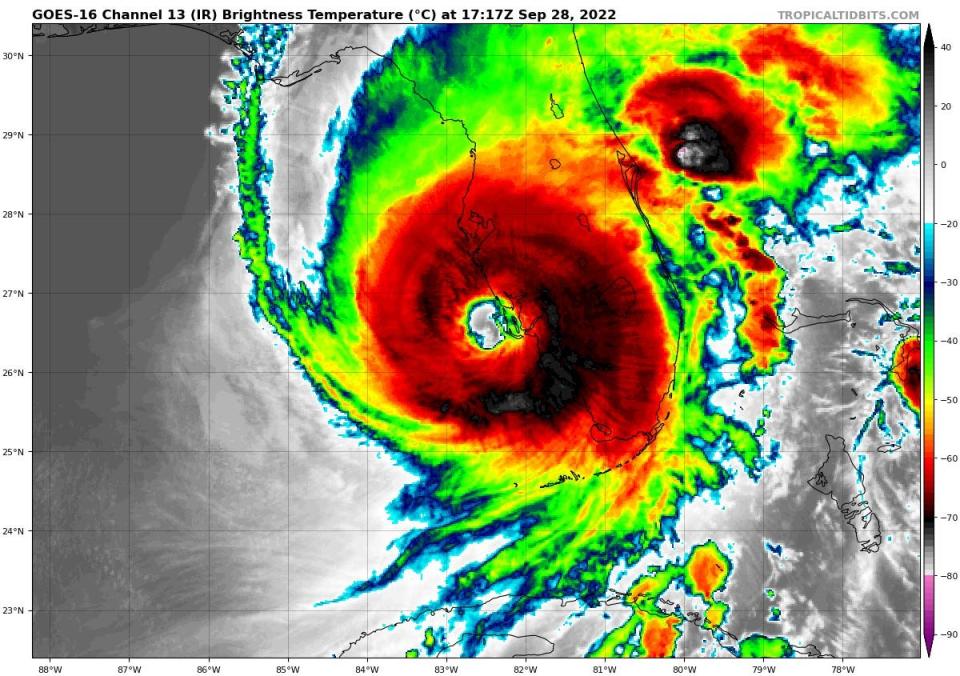Our hurricane rating method just won't cut it anymore
Hurricane Ian is dominating the news, as it should. Eventually, weather attribution experts will issue their reports on the role of climate change on its intensity and destructiveness. In the meantime we should note the inadequacy of the storm categories that media reports use to characterize storm power.
After crossing Cuba, warm Gulf water intensified Ian rapidly to a Category 4 storm just ahead of landfall. What does that tell us about the storm? Not as much as it should. Look at a composite radar image that shows two storms superimposed: 2022’s Ian and 2004’s Charley, both of which hit Florida as Category 4 storms at the same location. Although both were ranked as Category 4, the entirety of Charley fits inside just the eye of Ian! As you might suspect, the scope of devastation from Ian is going to far exceed that of Charley.
Hurricane Andrew: Category 5 Hurricane Andrew broke 42-year lucky streak, shattered illusions of safety for Florida
Property insurance: The property insurance market was melting down. Then Hurricane Ian flooded Southwest Florida
The Saffir-Simpson hurricane scale, which ranks storms from Category 1 to 5 according to maximum sustained wind speed over a one-minute time span, was introduced in 1973 to help predict potential structural damage. But it tells us nothing about the overall size of the storm, its duration, the amount of rainfall or the scale of flooding from the associated surge.

Meteorologists have developed more comprehensive metrics that can tell us much more. One example is Integrated Kinetic Energy (IKE), introduced by NOAA in 2007. This conveys the total energy of the storm in terajoules (TJ). The IKE for Hurricane Ian has already been calculated at 47 TJ, which is almost seven times as much as Charley and more than twice as much as 1992’s Andrew, which hit southeastern Florida as the costliest hurricane to make landfall in the U.S. at that time. Note that Andrew was also rated as a Category 4 when it hit Florida, again underlining the inadequacy of the Saffir-Simpson scale to compare storms. And to further drive this point home, while the Category 5 Katrina in 2005 hit an unprecedented IKE level of 121 TJ, that was even exceeded by 2012’s Superstorm Sandy at 141 TJ, even though Sandy’s peak wind speed put it only at Category 1 when it hit New Jersey! Another metric, developed by private company StormGeo, is Hurricane Severity Index (HSI). This is a 50-point scale that combines maximum wind speed with the size of the wind field. StormGeo shows how two hurricanes – Ivan and Dennis – that scored as Category 3 with max sustained winds of 120 mph, both hitting a similar part of the Gulf coast, were quite different in their impacts as revealed by their HSI and consequent damage. Dennis (HSI = 18) caused $4 billion of damage, but Ivan (HSI = 32) caused $32 billion.
So why do we still hang onto the old Saffir-Simpson scale?
Simplicity and familiarity. Or, to put it another way, “That’s how we always done it, so if it ain’t broke, don’t fix it.”
But in these days of tropical cyclones that are characterized by larger size, more total rainfall, rapid intensification, and a propensity to linger longer (see Hurricane Harvey), I say it is broke, and it does need to be fixed.
It’s not a stretch to foresee that people living in hurricane zones might be misled by reliance on news reports that a storm may be “only” a Category 2 or 3, when it may pose a bigger risk to their lives and property than a Category 4 or even 5, depending on characteristics that are not captured in those categories. This could literally be a matter of life or death, and clinging to “how we've always done it” is a poor excuse.
This piece was submitted by Richard Knight and Ed Ignatoff, of the Citizens’ Climate Lobby, Boca Raton Chapter.
This article originally appeared on Palm Beach Post: Commentary: Saffir-Simpson scale a bad indicator of hurricane strength

